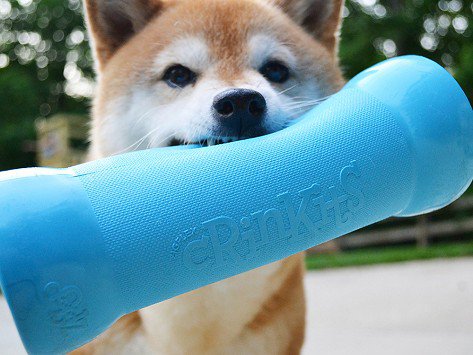One of the keys to having a well-behaved puppy is having the right toys. The amount of toys out there is quite incredible and it’s easy to be sucked in to buying the “cute,” the “inexpensive,” or even the “most expensive” (thinking it must be the best) or a toy simply because it has the word “Puppy” in the name.
However, there are some things you should be thinking about before buying any toy for your puppy, and it’s none of the things I just mentioned. In honor of National Puppy Day (March 23), here are tips to picking out toys for your puppy that will save you money on toys as well as avoid possible vet bills.

First, asses your puppy’s chewing and playing habits
One of the most important things to think about is your puppy’s personality. How they interact with their toys in very important for two reasons:
- You want to buy toys they will actually play with (otherwise it’s a waste of money)
- You want to buy toys they will not destroy in two seconds (waste of money and a possible hazard)
So, watch your puppy play and take note of the following behaviors:
Likes to destroy a toy – usually tearing out stuffing and looking for that squeaker to “kill it”
For this puppy, stuffed toys are probably not a good idea, since they are going to destroy them in a minute and they can ingest the pieces – especially if you aren’t home to watch them. Instead, pick out toys that are made to be ripped apart or have things pulled out over and over again. Also, more durable toys, like those made of rubber or canvas, may be better choices.

Likes toys that move – balls that roll, things they can fetch, etc.
These puppies may not be as interested in stuffies. Instead, opt for balls (rubber is better than a tennis ball, which can wear down their teeth!), rubber Frisbees (easier on the mouth than hard plastic), etc.

Likes soft toys to “cuddle” – use as pillows, carry in mouth but not chew.
These puppies will do fine with cute stuffies! You may want to avoid hard toys, balls, etc., because they won’t be as interested in them.

Likes to chew on toys endlessly – doesn’t try to rip them apart, but eventually will just by chewing
Make sure you avoid anything that cannot withstand chewing. Instead of stuffed animals, opt for rubber or rope toys that are made for chewing. Be sure to keep an eye on your puppy and take the toy away if it starts to rip it apart – small pieces can be swallowed.

Next, cross-reference the type of toy they like with their play habits above to narrow the field even further:
- Likes toys with a squeaker
- Likes quiet toys (some puppies are scared of that squeak!)
- Likes toys with texture for teething gums
- Likes toys that “crinkle”
Paying attention to this will help you narrow your search considerably. For example, a puppy that likes toys that crinkle but also like to “kill” them may do best with a plastic bottle encased in hard canvas, while avoiding toys like the flat crinkly stuffy, which could easily be destroyed. The toy shown below may be an even better choice – it’s made of a durable, flexible plastic.
Related: 9 Best Heartbeat Puppy Toys
Second, think about size
Be sure to keep your puppy’s size in mind. This includes their actual size, but more importantly, the size of their mouth. Many toys are labeled “puppy” because they are smaller. This may be just what you need if your puppy is a Chihuahua or even a Frenchie. However, they would be completely inappropriate for a Great Dane puppy that could swallow those toys whole.
For example, these puppy teething toys are labeled “XS”by Amazon and if you read the fine print on the packaging, it says for puppies up to 15 pounds. Even then, think about your dog’s mouth size more than his weight.
The main thing about size: DO NOT BUY ANY TOY THAT CAN FIT ENTIRELY IN YOUR PUPPY’s MOUTH, as it may be a choking hazard. Remember, puppies tend to try to swallow things more than adult dogs do. So while an adult dog may be perfectly safe with smaller toys, don’t trust that puppy just yet.
In addition, remember to take away toys if parts have broken off that are now small enough to swallow.
Third, think about strength
Another reason a toy may be labeled “puppy” is because it’s softer on those young jaws and teeth. Again, this may be perfect for some pups, but for others it can spell trouble.
For example, this “puppy chew bone” is made of soft rubber. Many puppies can easily chew these up and swallow the pieces. Buyer, beware!
 Make sure you are buying a dog toy that can withstand your dog’s strength and rough play. For some puppies, that may mean you buy toys geared toward “adults” or “heavy chewers.” For others, that puppy toy may be just fine.
Make sure you are buying a dog toy that can withstand your dog’s strength and rough play. For some puppies, that may mean you buy toys geared toward “adults” or “heavy chewers.” For others, that puppy toy may be just fine.

Not sure?
If you aren’t sure I always go by the “better safe than sorry” rule. Opt for the stronger, more durable toy first and see how it goes. Maybe bring home a softer toy for when you and your puppy play together – so he only has it when you can observe him to see if it’s an appropriate toy for him. Bottom line, it’s all about safety. After that, it’s about buying toys your puppy will engage with to keep them busy and help develop a bond with you through play.


